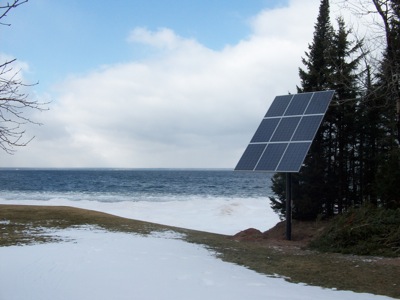by the Green Energy Solutions Team
Solar Power in the Great Lakes is often contemplated and argued about between those interested in renewables. Many naysayers often support the theory of the cool climates, high precipitation as a reason to avoid installing solar power. The myth supports the need for a cactus in your backyard in order to benefit from solar. While the winter wonderland in the north does play host to some of the record snowfall averages and lowest temperatures in the Midwest, it also teaches us that there is more to solar than meets the eye.
While solar radiation measurements are less than the Southern regions of the US, it might surprise you to know that radiation averages in the Great Lakes region are not far off pace from States like Arizona and New Mexico. The only problem is the summer season in the North is typically short-lived. The longest season tends to be the coldest season and often times the cloudiest. Cloud cover does account for some power losses in the long run, however there are factors unique to the great lakes region that gives Solar some strength.
Warmer climates tend to attract more people. Highly populated areas suffer from higher levels of smog or air pollution. This hampers solar production (maybe very little) but realistically air that is not clear
cuts down on solar radiation levels since they are being deflected by the air pollutants. The great North is known for its clear and starry skies, aurora borealis and beautiful moon lit nights yield two things, clear air and cold air. Fewer pollutants in the air allow for more solar radiation to get through keeping the more sustainable levels of radiation available for solar to utilize.
Cold air is a blessing to solar and annoying for Northern inhabitants. Solar panels are like car engines in that the cooler you get them the more efficient they become. While in a car more horsepower is the yield, solar panels that are kept cooler allow for higher voltages. The gets a more true power yield and a much more efficient panel. You might expect a 2.5 kW PV system to have a peak production after inversion of around 2.2-2.3 kW of actual production. But in a system kept cool you might actually see production numbers very close to rated output. This will never and can never happen in warm climates because of the heat in those regions.
So to those who dismiss solar in the great lakes regions or any other northern location, as mom always said; “You can’t judge a book by its cover!” People in the Great Lakes regions of Minnesota, Wisconsin, Michigan, Illinois and Ohio have been enjoying these benefits for a long time. Many who have had solar since it first became popular are returning to it again. Hunting camps and summer cabins abound throughout the region have enjoyed Solar and wind power for decades. You don’t want to scare off the big buck with a generator! Off-grid living is also more than possible here and is thriving on solar.
As technology gets better and alternative energy becomes more affordable we will always push the boundaries of these systems and how we use them. Where we use them will be explored more and more as we see energy needs increase. One thing is for sure the price of energy isn’t getting cheaper anytime too soon and to argue the feasibility of these systems in various regions can become a very informative lesson for all of us.



Leave a Reply
You must be logged in to post a comment.